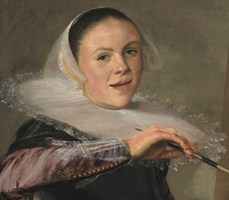By: Marina V | Date Added:

Judith Jans Leyster (also Leijster) was a Dutch Golden Age painter. Typical of Dutch artists during this period, Leyster worked on genre paintings, still life, and portraits. The details behind her artistic training are unclear, but she was one of the first women admitted to the painter’s guild in Haarlem. She later ran a successful workshop with several male apprentices and was known for the relaxed, informal nature of her portraits. While she was quite successful during her lifetime, her reputation suffered after her death due to unfortunate circumstances. Her entire oeuvre was passed off as work either by her contemporary Frans Hals or by her husband. In many cases, her signature was covered by collectors looking to make a profit due to the high market value of Frans Hals’ work. Only in the late 19th century were these errors discovered and scholars began to gain a renewed appreciation for Leyster’s skill as an artist. She signed her works with a monogram of her initials JL with a star attached. This was a play on words: "Leister" meant "Lead star" in Dutch and for Dutch mariners of the time it was the common name for the North Star. The Leistar was the name of her father's brewery in Haarlem. Only occasionally did she sign her works with her full name. Judith Leyster specialized in portrait-like genre scenes, typically of one to three figures, who generally exude good cheer and are shown against a plain background. Many are children; others men with drink. Leyster was particularly innovative in her domestic genre scenes. These are quiet scenes of women at home, often with candle- or lamplight, particularly from a woman's point of view. The Proposition (Mauritshuis, The Hague) is an unusual variant on these scenes, said by some to show a girl receiving unwelcome advances, instead of depicting a willing prostitute, the more common scene under such a title. However, this interpretation is not universally accepted. Much of her other work, especially in music-makers, was similar in nature to that of many of her contemporaries, such as her husband Molenaer, the brothers Frans and Dirck Hals, Jan Steen, and the Utrecht Caravaggisti Hendrick Terbrugghen and Gerrit van Honthorst. Their genre paintings, generally of taverns and other scenes of entertainment, catered to the tastes and interests of a growing segment of the Dutch middle class. She painted few actual portraits, and her only known history painting is David with the head of Goliath (1633), which does not depart from her typical portrait style, with a single figure close to the front of the picture space. Although well-known during her lifetime and esteemed by her contemporaries, Leyster and her work were largely forgotten after her death. She was rediscovered in 1893, when a painting admired for over a century as a work of Frans Hals was recognized as hers. Leyster's work was criticized as showing the "weakness of the feminine hand" while many of her paintings were attributed to Frans Hals.[16] The confusion–or perhaps deceit–may date to Leyster's lifetime. Sir Luke Schaud acquired a Leyster, The Jolly Companions, as a Hals in the 1600s. The work ended up with a dealer, Wertheimer of Bond Street, London, who described it as one of the finest Hals paintings.[17] Sir John Millars agreed with the Wertheimer about the authenticity and value of the painting. Wertheimer sold the painting to an English firm for £4,500. This firm, in turn, sold the painting as a Hals to Baron Schlichting in Paris. In 1893 the Louvre found Leyster's monogram under the fabricated signature of Hals. It is not clear when the false signature had been added. When the original signature was discovered, Baron Schlichting sued the English firm, who in turn attempted to rescind their own purchase and get their money back from the art dealer, Wertheimer. The case was settled in court on 31 May 1893, with the plaintiffs (the unnamed English firm) agreeing to keep the painting for £3,500 + £500 costs. During the legal proceedings, there was no consideration for the work as an object of value under its new history: "at no time did anyone throw his cap in the air and rejoice that another painter, capable of equaling Hals at his best, had been discovered". Another version of The Jolly Companions had been sold in Brussels in 1890 and bore Leyster's monogram "crudely altered to an interlocking FH". In 1893 Cornelis Hofstede de Groot wrote the first article on Leyster. He attributed seven paintings to her, six of which are signed with her distinctive monogram 'JL*'. Art historians since then have often dismissed her as an imitator or follower of Hals, although this attitude changed somewhat in the late 20th century. Apart from the lawsuit mentioned above, the nature of Leyster's professional relationship with Frans Hals is unclear; she may have been his student or else a friendly colleague. She may have been a witness at the baptism of Hals' daughter Maria in the early 1630s, since a "Judith Jansder" (meaning "daughter of Jan") was recorded as a witness, but there were other Judith Janses in Haarlem. Some historians have asserted that Hals or his brother Dirck may have been Leyster's teacher, owing to the close similarities between their works.
Share your thoughts on this story with us. Your comments will not be made public.
Email
Copyright ©2016 - Design By Bureau Blank